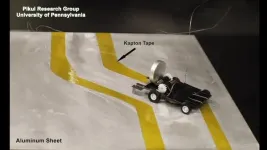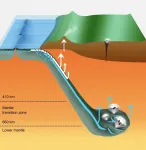(Press-News.org) When it comes to powering mobile robots, batteries present a problematic paradox: the more energy they contain, the more they weigh, and thus the more energy the robot needs to move. Energy harvesters, like solar panels, might work for some applications, but they don't deliver power quickly or consistently enough for sustained travel.
James Pikul, assistant professor in Penn Engineering's Department of Mechanical Engineering and Applied Mechanics, is developing robot-powering technology that has the best of both worlds. His environmentally controlled voltage source, or ECVS, works like a battery, in that the energy is produced by repeatedly breaking and forming chemical bonds, but it escapes the weight paradox by finding those chemical bonds in the robot's environment, like a harvester. While in contact with a metal surface, an ECVS unit catalyzes an oxidation reaction with the surrounding air, powering the robot with the freed electrons.
Pikul's approach was inspired by how animals power themselves through foraging for chemical bonds in the form of food. And like a simple organism, these ECVS-powered robots are now capable of searching for their own food sources despite lacking a "brain."
In a new study published as an Editor's Choice article in Advanced Intelligent Systems, Pikul, along with lab members Min Wang and Yue Gao, demonstrate a wheeled robot that can navigate its environment without a computer. By having the left and right wheels of the robot powered by different ECVS units, they show a rudimentary form of navigation and foraging, where the robot will automatically steer toward metallic surfaces it can "eat."
Their study also outlines more complicated behavior that can be achieved without a central processor. With different spatial and sequential arrangements of ECVS units, a robot can perform a variety of logical operations based on the presence or absence of its food source.
"Bacteria are able to autonomously navigate toward nutrients through a process called chemotaxis, where they sense and respond to changes in chemical concentrations," Pikul says. "Small robots have similar constraints to microorganisms, since they can't carry big batteries or complicated computers, so we wanted to explore how our ECVS technology could replicate that kind of behavior."
In the researchers' experiments, they placed their robot on aluminum surfaces capable of powering its ECVS units. By adding "hazards" that would prevent the robot from making contact with the metal, they showed how ECVS units could both get the robot moving and navigate it toward more energy-rich sources.
"In some ways," Pikul says, "they are like a tongue in that they both sense and help digest energy."
One type of hazard was a curving path of insulating tape. The researchers showed that the robot would autonomously follow the metal lane in between two lines of tape if its EVCS units were wired to the wheels on the opposite side. If the lane curved to the left, for example, the ECVS on the right side of the robot would begin to lose power first, slowing the robot's left wheels and causing it to turn away from the hazard.
Another hazard took the form of a viscous insulating gel, which the robot could gradually wipe away by driving over it. Since the thickness of the gel was directly related to the amount of power the robot's ECVS units could draw from the metal underneath it, the researchers were able to show that the robot's turning radius was responsive to that sort of environmental signal.
By understanding the types of cues ECVS units can pick up, the researchers can devise different ways of incorporating them into the design of a robot in order to achieve the desired type of navigation.
"Wiring the ECVS units to opposite motors allows the robot to avoid the surfaces they don't like," says Pikul. "But when the ECVS units are in parallel to both motors, they operate like an 'OR' gate, in that they ignore chemical or physical changes that occur under just one power source."
"We can use this sort of wiring to match biological preferences," he says. "It's important to be able to tell the difference between environments that are dangerous and need to be avoided, and ones that are just inconvenient and can be passed through if necessary."
As ECVS technology evolves, they can be used to program even more complicated and responsive behaviors in autonomous, computerless robots. By matching the ECVS design to the environment that a robot needs to operate in, Pikul envisions tiny robots that crawl through rubble or other hazardous environments, getting sensors to critical locations while preserving themselves.
"If we have different ECVS that are tuned to different chemistries, we can have robots that avoid surfaces that are dangerous, but power through ones that stand in the way of an objective," Pikul says.
INFORMATION:
In looking at the broader impact of the COVID-19 pandemic on health and wellbeing, public health experts are examining screening rates for cancer. A new study looking at U.S. mammography screening rates during the first five months of the pandemic found both a strong rebound in breast cancer screening rates and a concerning cumulative deficit in mammograms due to missed appointments, as well as uncovering disparities when looking at screening according to race.
The study was released this week in the Journal of the National Cancer Institute.
Conducted by investigators from the Breast Cancer Surveillance Coalition (BCSC), a federally-funded, national network of breast imaging registries, the study sought to quantify the impact of the COVID-19 ...
Denver, CO, March 31, 2020 - Children with Down syndrome are 20-times more likely to develop acute lymphocytic leukemia (ALL) and 150-times more likely to develop acute myeloid leukemia (AML) compared to their typical peers. According to a new study by researchers at the Linda Crnic Institute for Down Syndrome, the reason could be that children with Down syndrome are more likely to present with clonal hematopoiesis (CH), a process in which a blood stem cell acquires a genetic mutation that promotes replication.
The findings, published online by Blood Advances, add to a growing body of evidence, much of which has been established ...
Washington, DC-- Diamonds that formed deep in the Earth's mantle contain evidence of chemical reactions that occurred on the seafloor. Probing these gems can help geoscientists understand how material is exchanged between the planet's surface and its depths.
New work published in Science Advances confirms that serpentinite--a rock that forms from peridotite, the main rock type in Earth's mantle, when water penetrates cracks in the ocean floor--can carry surface water as far as 700 kilometers deep by plate tectonic processes.
"Nearly all tectonic plates that make up the seafloor eventually bend and slide down into ...
PITTSBURGH --31 March 2021 - A detailed examination of more than 10,000 medical records at maternity clinics and hospitals in urban Malawi, South Africa, Uganda and Zimbabwe has yielded important insight about pregnancy and neonatal outcomes in these communities as well as the frequency with which different complications occur. The findings, which were published in PLOS ONE, include data not often available or reported in much of eastern and southern Africa.
The medical chart review was undertaken by researchers from the National Institutes of Health-funded Microbicide Trials Network ...
A new study has found the first evidence of sophisticated breathing organs in 450-million-year-old sea creatures. Contrary to previous thought, trilobites were leg breathers, with structures resembling gills hanging off their thighs.
Trilobites were a group of marine animals with half-moon-like heads that resembled horseshoe crabs, and they were wildly successful in terms of evolution. Though they are now extinct, they survived for more than 250 million years -- longer than the dinosaurs.
Thanks to new technologies and an extremely rare set of fossils, scientists from UC Riverside can now show that trilobites breathed oxygen and explain how ...
March 31, 2021 - The United States is facing a persistent and worsening shortage of physicians specializing in preventive medicine, reports a study in the Journal of Public Health Management and Practice. The journal is published in the Lippincott portfolio by Wolters Kluwer.
"The number of preventive medicine physicians is not likely to match population needs in the United States in the near term and beyond," according to the new research by Thomas Ricketts, Ph.D., MPH, and colleagues of University of North Carolina at Chapel Hill. The study appears ...
DETROIT (March 31, 2021) - In a study that looked at racial differences in outcomes of COVID-19 patients admitted to the intensive care unit, researchers at Henry Ford Hospital in Detroit found that patients of color had a lower 28-day mortality than white patients.
Race, however, was not a factor in overall hospital mortality, length of stay in the ICU or in the rate of patients placed on mechanical ventilation, researchers said.
The findings, published in Critical Care Medicine, are believed to be one of the first in the United States to study racial differences and outcomes specific to patients hospitalized ...
An enormous telescope complex in Tibet has captured the first evidence of ultrahigh-energy gamma rays spread across the Milky Way. The findings offer proof that undetected starry accelerators churn out cosmic rays, which have floated around our galaxy for millions of years. The research is to be published in the journal Physical Review Letters on Monday, April 5.
"We found 23 ultrahigh-energy cosmic gamma rays along the Milky Way," said Kazumasa Kawata, a coauthor from the University of Tokyo. "The highest energy among them amounts to a world record: nearly one petaelectron volt."
That's three ...
DURHAM, N.H.-- As the Biden administration announces a plan to expand the development of offshore wind energy development (OWD) along the East Coast, research from the University of New Hampshire shows significant support from an unlikely group, coastal recreation visitors. From boat enthusiasts to anglers, researchers found surprisingly widespread support with close to 77% of coastal recreation visitors supporting potential OWD along the N.H. Seacoast.
"This study takes a closer look at the lingering assumption that offshore wind in the United States might hurt coastal recreation ...
The first imaging of substantial freshwater plumes west of Hawai'i Island may help water planners to optimize sustainable yields and aquifer storage calculations. University of Hawai'i at Mānoa researchers demonstrated a new method to detect freshwater plumes between the seafloor and ocean surface in a study recently published in Geophysical Research Letters.
The research, supported by the Hawai'i EPSCoR 'Ike Wai project, is the first to demonstrate that surface-towed marine controlled-source electromagnetic (CSEM) imaging can be used to map oceanic freshwater plumes in high-resolution. It is an extension of the groundbreaking discovery of freshwater beneath the seafloor in 2020. Both are important findings in a world facing climate change, where ...






